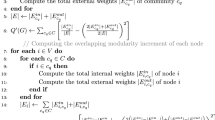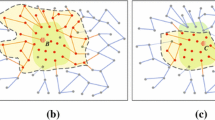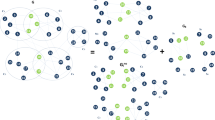Abstract
Real social network feature many small groups with information exchange among groups. Groups often overlap with each other, and individuals can be in multiple groups. By simulating the information transmission process in different networks with structural changes, we can obtain a deeper understanding of the attribute characteristics of complex networks and the law of information transmission. Therefore, to study the process of information exchange and dissemination in complex and overlapping group networks, this paper first constructs the friend circles network (FCnet) and then proposes a dynamic information dissemination circle-susceptible–infected–removed (C-SIR) model. In this model, we discuss the extent of interest and impact among neighbours in the same circle and cross circles in FCnet, as well as the scale of imminent connections between circles. The validity and authenticity of the model are verified based on synthetic data and real data, and the conclusion that the C-SIR model can accelerate information propagation, maintain popularity, and expand the infection radius is obtained.













Similar content being viewed by others
References
Lu M, Zhang Z, Qu Z et al (2018) LPANNI: overlapping community detection using label propagation in large-scale complex networks. IEEE Trans Knowl Data Eng 31:1736–1749
Wang M, Zuo W, Wang Y (2016) An improved density peaks-based clustering method for social circle discovery in social networks. Neurocomputing. 179:219–227
Aral S, Dhillon PS (2018) Social influence maximization under empirical influence models. Nat Hum Behav 2:375–382
Gomez-Rodriguez M, Song L, Du N et al (2016) Influence estimation and maximization in continuous-time diffusion networks. ACM Trans Inf Syst 34:1–33
Ko YY, Cho KJ, Kim SW (2018) Efficient and effective influence maximization in social networks: a hybrid-approach. Inform Sci 465:144–161
Shang Y (2017) Subgraph robustness of complex networks under attacks. IEEE Trans Syst Man Cybern Syst 49:821–832
Vosoughi S, Roy D, Aral S (2018) The spread of true and false news online. Science. 359:1146–1151
Li L, Liu Y, Zhou Q, Yang W, Yuan J (2020) Targeted influence maximization under a multifactor-based information propagation model. Inf Sci 519:124–140
Zhang Y, Yang C, Huang K, Jusup M, Wang Z, Li X (2020) Reconstructing heterogeneous networks via compressive sensing and clustering. IEEE Trans Emerg Topics Comput Intell:1–11
Petrović G, Fujita H (2016) Soner: social network ranker [J]. Neurocomputing. 202:104–107
Perc M, Jordan JJ, Rand DG et al (2017) Statistical physics of human cooperation. Physics Reports 687:1–51
Rhouma D, Romdhane LB (2014) An efficient algorithm for community mining with overlap in social networks. Expert Syst Applications 41:4309–4321
Li S, Song X, Lu H, Zeng L, Shi M, Liu F (2020) Friend recommendation for cross marketing in online brand community based on intelligent attention allocation link prediction algorithm. Expert Syst Appl 139(112839):112839
Wang C, Hao C, Guan X (2020) Hierarchical and overlapping social circle identification in ego networks based on link clustering. Neurocomputing. 381:322–335
Zhang S, Wu L, Zhou Y (2020) The impact of negative list policy on sectoral structure: based on complex network and DID analysis. Appl Energy 278:115714
Huang K, Wang Z, Jusup M (2018) Incorporating latent constraints to enhance inference of network structure. IEEE Trans Netw Sci Eng
Ju C, Tao W (2017) Relationship strength estimation based on Wechat friends circle. Neurocomputing. 253:15–23
Zhang ZK, Liu C, Zhan XX et al (2016) Dynamics of information diffusion and its applications on complex networks. Physics Rep 651:1–34
Kermack WO, McKendrick AG (1932) Contributions to the mathematical theory of epidemics. II.—The problem of endemicity. Proceedings of the Royal Society of London. Series A, containing papers of a mathematical and physical character 138:55–83
Kermack WO, McKendrick AG (1927) A contribution to the mathematical theory of epidemics. Proceedings of the royal society of london. Series A, Containing papers of a mathematical and physical character 115:700–721
Wan J, Chen X, Du Y et al (2019) Information propagation model based on hybrid social factors of opportunity, trust and motivation. Neurocomputing 333:169–184
Nian F, Diao H (2019) A human flesh search model based on multiple effects. IEEE Trans Netw Sci Eng
Zhang S, Wu T, Wang W, Lin T (2019) Irreversible contact process on complex networks with dynamical recovery probability. Physica A Stat Mech Appl 527(121336):121336
Prasse B, Van Mieghem P (2020) Network reconstruction and prediction of epidemic outbreaks for general group-based compartmental epidemic models. IEEE Trans Netw Sci Eng 7:2755–2764
Yao Y, Li Y, Xiong X, Wu Y, Lin H, Ju S (2020) An interactive propagation model of multiple information in complex networks. Physica A Stat Mech Appl 537(122764):122764
Zhu H, Ma J, Li S (2019) Effects of online and offline interaction on rumor propagation in activity-driven networks. Physica A Stat Mech Appl 525:1124–1135
Leskovec J, Krevl A (2014) SNAP Datasets: Stanford large network dataset collection,” http://snap.stanford.edu/data, Jun (2014)
Acknowledgments
This research is supported by the National Natural Science Foundation of China (No. 61863025), Pro-gram for International S & T Cooperation Projects of Gansu Province (No. 144WCGA166), Program for Longyuan Young Innovation Talents and the Doctor-al Foundation of LUT.
Author information
Authors and Affiliations
Corresponding author
Ethics declarations
Conflict of interest
The authors declare that they have no known competing financial interests or personal relationships that could have appeared to influence the work reported in this paper.
Additional information
Publisher’s note
Springer Nature remains neutral with regard to jurisdictional claims in published maps and institutional affiliations.
Rights and permissions
About this article
Cite this article
Nian, F., Liu, X. Friend circles network: formation and the law of news dissemination. Appl Intell 52, 889–902 (2022). https://doi.org/10.1007/s10489-021-02398-z
Accepted:
Published:
Issue Date:
DOI: https://doi.org/10.1007/s10489-021-02398-z




